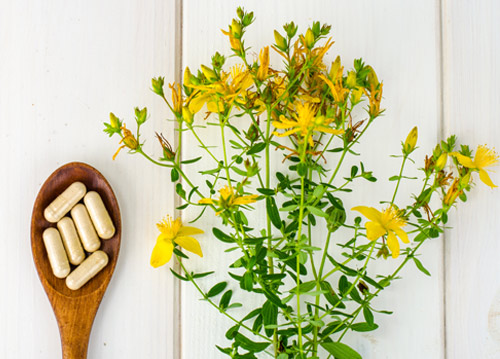
What is the menopause? Causes, symptoms, and treatments
The menopause is a normal and natural part of a woman's life-cycle. We look at signs that it has begun, common symptoms, and a range of steps you can take to increase the chances of a comfortable menopause.
- Why do women go through the menopause?
- When does the menopause start?
- What are the most common signs of the menopause?
- Do all women experience menopause in the same way?
- Are menopause symptoms permanent?
- What are the best treatments for menopause symptoms?
- Which supplements can help women going through the menopause?
- Summary
Why do women go through the menopause?
The menopause is a gradual decline in ovarian function, during which a woman eventually stops menstruating entirely and can no longer become pregnant.
It is marked by a fluctuation in hormone levels, especially a drop in oestrogen and eventually progesterone.
Scientists have not been able to determine why the menopause occurs, although there are several different evolutionary theories - for example, some researchers think that grandmothers who were no longer fertile helped to ensure the survival of their grandchildren in the wild. Only five species are known to go through the menopause - humans and four different kinds of whale.
The menopause is divided into three phases:
- Premenopause. Before a woman's final period she may experience several years her hormone levels drop or vary. This can cause a number of different changes including irregular menstruation.
- Perimenopause. This is the transition period leading up to a woman's final menstruation, normally lasting four to eight years. During this time it is still possible to become pregnant, although the chances are usually low. Oestrogen levels will fluctuate even more and a number of common symptoms may appear, including very irregular periods, hot flashes, vaginal dryness and mood changes.
- Postmenopause. A woman is considered to be postmenopausal a year after her final flow, when her ovaries are inactive. Hormone levels will still drop and fluctuate for a while, which means that some symptoms experienced during the perimenopause may continue. After the menopause a woman is likely to go through physical changes, some of which are obvious (such as a different body shape) and others less obvious (including an increased risk of osteoporosis and heart disease).
When does the menopause start?
Most women experience the start of the menopause between the ages of 45 and 55. In the UK the average age is 51.
Some women, however, go through the menopause early (in their early 40s, for example). There is some evidence that lifestyle factors can influence this - pollution, smoking, stress and lack of exercise may bring on an early menopause. Regular sex and a good diet including dairy foods, plenty of plant-based protein and nutrients like zinc and vitamin B6 might help to delay the onset.1, 2, 3
What are the most common signs of the menopause?
Fluctuating hormone levels cause a number of common symptoms that tend to indicate that the menopause is taking place. These symptoms can vary during the premenopause, perimenopause and postmenopause.
1. Hot flushes
Vasomotor symptoms, commonly known as hot flushes or hot flashes, are reported by up to 85% of women going through the menopause, making them the most common symptom.4 In many cases they even begin before menopause sets in.
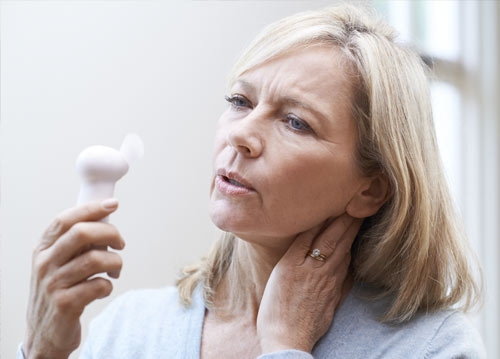
Hot flushes are a sensation of being very hot that can come on at any time, affecting the whole body and lasting for several minutes. They can make your face flush and cause palpitations and increased sweating - waking up with these symptoms is sometimes called ‘night sweats'.
Some women experience hot flushes several times per day and find that they get in the way of normal life. They may even find them embarrassing. Other women don't have them very often and find them to be only a minor inconvenience.
Nobody is sure what causes hot flushes, though it may be because changes to oestrogen production affect the system in the body that regulates heat. They can be triggered by stress or anxiety; health conditions such as diabetes; caffeine, alcohol and smoking; high temperature caused by an illness, spicy food or thick clothes; and some medications and treatments.5
Hot flushes usually go on for about five years, although less intense versions may continue afterwards and 25% of women continue to have them for five or more years after menopause has ended.6, 7
2. Changes to menstruation
The start of menopause is often defined by changes to menstruation, although some women will go through most of the menopause with regular periods while experiencing some of the other symptoms. Periods may also be more painful than usual.

The flow of hormones defines when and how often a woman has a period, so as hormone levels fluctuate during the menopause a woman is likely to experience irregular periods, especially during the later stages.
Bleeding may also vary, and some women may experience very light bleeding, spotting, intermittent flow or merely cramps or a brown discharge without any bleeding at all.
During premenopause periods may become more frequent than normal, and during the perimenopause an irregular cycle could mean skipping a period for several months. Bleeding after the menopause can be a sign that something is wrong. You should consult your doctor if this happens.
3. Vaginal dryness and vulvovaginal atrophy
Vaginal dryness is another common symptom of menopause, experienced in a moderate or severe form by many of women.8
Changes to oestrogen production affect the sensitive tissues of the vagina and reduces the amount of vaginal fluid/discharge. This can cause itching and soreness and make sex painful.
The loss of oestrogen in menopause can also cause shortening of the vagina or uterine prolapse, and also affects the urinary tract which causes frequent urination and may lead to infections.
Women with minor dryness and discomfort can ameliorate the symptoms with creams and lubricants, but severe vulvovaginal atrophy will only improve with hormone treatment.
4. Poor sleep
The menopause is associated with poor sleep : after the menopause, more than 50% of women report that they sleep badly.9
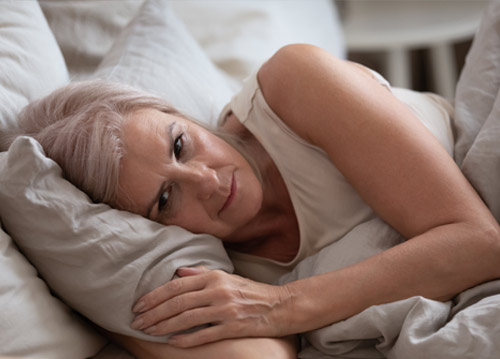
This is probably related to hormones among other causes, and can be made worse by symptoms such as night sweats. Older women already report more sleep difficulties than men, and poor sleep is also associated with everything from restless leg syndrome to anxiety and depression.
Treating poor sleep often depends on whether the woman is experiencing any of these other symptoms, which are addressed with a range of different measures.
5. Changes to mood and cognition
Women are 2-4 times more likely to be depressed during menopause.10 Those who have previously experienced a depressive episode become even more likely to have one again.
Sometimes, menopausal women experience anxiety before a depressive episode.11 Other mood changes that are commonly reported include trouble concentrating, irritability/aggression and a lack of motivation.
Depression during menopause may be caused by hormonal changes - we know that those with strongly fluctuating oestrogen levels are more likely to be affected1 - or by related problems like poor sleep.
However, it is difficult to determine the extent to which these emotional changes are caused by the menopause itself, and how many are related to events that often occur at the same time of life (e.g. the loss of a parent, taking on the role of a carer, children growing older). These feelings may also be related to social stigma around the menopause or the idea of growing older.12
Some women also report that their memory gets worse with the onset of menopause, especially in the early stages. There is evidence that oestrogen and cognitive function are connected - for example, verbal memory performance actually varies during the menstrual cycle.13
Oestrogen/hormone therapies of different kinds have shown good but mixed results in reversing the possible cognitive effects of menopause.14, 15, 16
However, it isn't clear whether the cognitive differences that some women report are caused by the menopause or are age-related, because normal cognitive decline also begins at around 50 years old.
Do all women experience menopause in the same way?
No. The age at which menopause begins can vary by decades. Some women experience more symptoms than others, and the severity of the symptoms also varies. For example, hot flushes may continue for years postmenopause, whereas other women do not get hot flushes at all.
Some evidence suggests that the age of menopause and the severity of some symptoms changes according to lifestyle factors including diet and exercise.1, 2, 3
Are menopause symptoms permanent?
Many of the symptoms associated with menopause will pass once hormone levels become more stable, although this can take a long time after the final menstruation - for some women they will go on for many years.
For examples, hot flushes usually go on for about five years, although less intense versions may continue afterwards and 25% of women continue to have them for five or more years after menopause has ended.6, 7
Women who have used hormone replacement therapy may find that the hot flashes begin after they have stopped suppressing them with HRT, even if it has been many years since their last period.
There are also long-term physical changes that post-menopausal women should be aware of.
Post menopausal women are more likely to develop heart disease because oestrogen plays a role in controlling cholesterol. With less oestrogen it is more likely that artery walls will narrow and that plaques will build up, increasing the chances of experiencing a stroke or heart attack. It is recommended to go for routine checkups to make sure that cholesterol is under control and to look for other risk factors. A healthy diet and regular exercise can help.17
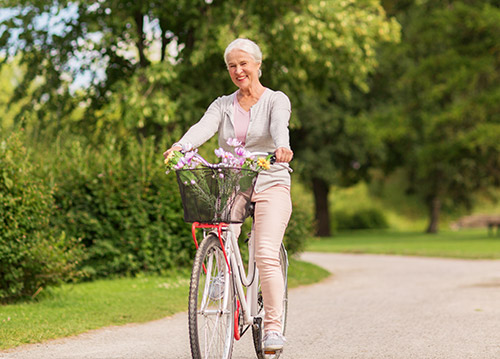
Oestrogen is also important for keeping bones strong. After oestrogen levels decline, women are at a greater risk of developing osteoporosis or suffering a fracture. The time that bone loss is at its worst is in the late perimenopause and the years just after menopause.18
Dietary changes can help to alleviate this, especially ensuring that the body is getting enough calcium, vitamin D and vitamin K2. Consuming the right foods is important, but supplements can also help with this - especially vitamin K2, which allows the body to use the calcium it absorbs to help strengthen bones, but which is largely absent from the western diet.19
The menopause also changes a woman's body in other ways. Most experience weight gain, because the body reacts to the loss of oestrogen by trying to create more oestrogen-producing fat cells, especially around the belly - however, weight gain around this age is more frequently related to age and lifestyle.
Less oestrogen can also cause hair loss (on the head) or hair growth in unusual places such as the face. It can lead to brittle nails, and it can continue to affect the bladder, urinary tract and vagina. Hormonal changes can also affect libido, although as with many other symptoms associated with menopause this may be related to other changes at this time of life.
What are the best treatments for menopause symptoms?
Hormone replacement therapy
Many of the symptoms of menopause are caused by a drop in hormone levels. Hormone replacement therapy (HRT) tops up these hormones - usually with oestrogen and progestogen - to provide relief. HRT comes in many forms, from creams and tablets to patches, pessaries and rings.
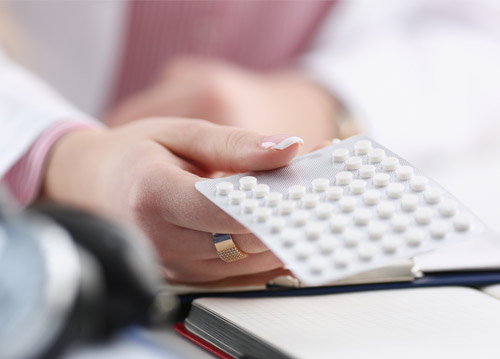
A majority of the common symptoms of menopause can be addressed with HRT, including hot flushes, night sweats, mood swings, vaginal dryness and reduced sex drive, and it can help to stop weakening of the bones.20
Women who have begun to experience the first signs of the menopause can go on HRT after a conversation with their GP. There are different types of HRT, so it may take a little while to find the right one.
Some women prefer not to use hormone replacement therapy. There are different reasons for this. For example, most people stop taking it after menopause has ended but hot flushes will occur whenever hormone levels change, so HRT will only delay them rather than getting rid of the symptoms altogether.
There are also risks to HRT, although the benefits are usually enough to justify them. Side effects sometimes occur for three months or so, such as headaches, sickness and vaginal bleeding. There is also an increased risk of breast cancer for some women.21, 22
Doctors may recommend alternatives to HRT for women with high blood pressure, a history of blood clots, liver disease or a history of breast, ovarian or womb cancer,.
Creams and lubricants
Vaginal dryness and vulvovaginal atrophy can be addressed with creams and lubricants if the symptoms are minor. More serious symptoms will only improve with treatment. Hormone therapy can reverse the changes. However, this does not help to address the increased risk of urinary tract infection and may actually make it worse.23, 24
Therapy
Antidepressants and psychotherapy (such as cognitive behavioural therapy) - either separately or in combination - are common treatments for the mood changes associated with menopause. Hormonal changes seem to be related to depression during menopause, but oestrogen therapy has only shown good results for women during the process but not afterwards.
There are also other ways to deal with the mental strain that can occur at this time of life, such as staying in touch with friends and family or trying out breathing and relaxation techniques.
People struggling with mental health issues should always consult a doctor.
Which supplements can help women going through the menopause?
Along with these common treatments, many people also try nutritional supplements and traditional herbal remedies as a way to alleviate menopause symptoms.
-
Black cohosh
A traditional herbal remedy, black cohosh supplements extracted from this North American plant are used for some of the most common menopause symptoms: hot flushes, night sweats and mood changes.25
-
St John's wort
A shrub long used as a herbal remedy, St John's wort can help with several aspects of menopause including mood changes and hot flushes.26

-
Red clover/phytoestrogens
Another traditional herbal remedy, red clover has been used to help control hot flushes. And to help maintain a calm and comfortable menopause.27
The benefits are believed to come from the naturally occuring ‘phytoestrogens' - hormone-like chemicals called isoflavones found in red clover - isoflavones in soya have also been suggested as a potential remedy for menopause symptoms.

-
Flaxseed
An ancient crop that is also notable for its high omega-3 content, flaxseed may also help with hot flushes.28
-
Sage
The popular cooking herb sage is also known to help many women with hot flushes and sweating.29

-
Sea buckthorn
Supplements made from an oil extracted from this Eurasian shrub may have a positive impact on vaginal dryness/atrophy.30
-
Supplements for bone strength.
Calcium, vitamin K2 and vitamin D are all important for bone strength. After menopause women are at greater risk of fractures and osteoporosis, so getting enough of these nutrients is more important than ever.
-
Natural lubricants
Applying lubricants topically can help to relieve vaginal atrophy and dryness. These can be made with natural ingredients such as aloe vera and flax seed extract.
Summary
The menopause is a natural and normal stage of life.
Women experience the menopause in different ways. However, for some it is accompanied by some unpleasant symptoms like hot flushes, vaginal dryness, decreased libido and irritability. These symptoms can last for years after a woman's final flow.
Hormone replacement therapy is a common way to help, but other options are also available to help make life a little easier.
References
1. Arnot M, Mace R. Sexual frequency is associated with age of natural menopause: results from the Study of Women's Health Across the Nation. Royal Society Open Science. https://doi.org/10.1098/rsos.191020
2. Purdue-Smithe A, Whitcomb B, Manson J, Hankinson S, Troy L, Bertone-Johnson E. A Prospective Study of Dairy Food Intake and Early Menopause. American Journal of Epidemiology. 188. 10.1093/aje/kwy212.
3. Dunneram Y, Greenwood DC, Burley VJ, et alDietary intake and age at natural menopause: results from the UK Women's Cohort StudyJ Epidemiol Community Health 2018;72:733-740.
4. ACOG practice bulletic No. 141: management of menopausal symptoms. Obstet Gynecol. 2014; 123:202-216 [PubMed: 24463691]
5. https://www.nhs.uk/conditions/menopause/hot-flushes/
6. Politi MC, Schleinitz MD, Col NF. Revisiting the duration of vasomotor symptoms of menopause: a meta-analysis. J Gen Intern Med. 2008; 23:1507-1513. [PubMed: 18521690]
7. Col NF, Guthrie JR, Politi M, et al. Duration of vasomotor symptoms in middle-aged women: a longitudinal study. Menopause. 2009; 16:453-457. [PubMed: 19188852]
8. Santoro, Nanette & Komi, Janne. (2009). Prevalence and Impact of Vaginal Symptoms among Postmenopausal Women. The journal of sexual medicine. 6. 2133-42. 10.1111/j.1743-6109.2009.01335.x.
9. Sherman S, Miller H, Nerukar L, et al. NIH state-of-the-science conference on management of menopause-related symptoms, March 21-25, 2005. Am J Med. 2005; 118(suppl 2): 1-172.
10. Schmidt, Peter & Haq, Nazli & Rubinow, David. (2005). A Longitudinal Evaluation of the Relationship Between Reproductive Status and Mood in Perimenopausal Women. The American journal of psychiatry. 161. 2238-44. 10.1176/appi.ajp.161.12.2238.
11. Kravitz, H & Schott, L & Joffe, Hadine & Cyranowski, J.M. & Bromberger, J. (2014). Do anxiety symptoms predict major depressive disorder in midlife women? The Study of Women's Health Across the Nation (SWAN) Mental Health Study (MHS). Psychological medicine. 44. 1-10. 10.1017/S0033291714000075.
12. Freeman EW, Sammel MD, Lin H, Nelson DB. Associations of Hormones and Menopausal Status With Depressed Mood in Women With No History of Depression. Arch Gen Psychiatry. 2006;63(4):375–382. doi:10.1001/archpsyc.63.4.375
13. Phillips SM, Sherwin BB. Effects of estrogen on memory function in surgically menopausal women. Psychoneurodocrinology. 1992; 17:485-495
14. Maki PM, Sundermann E. Hormone therapy and cognitive function. Hum Reprod Update. 2009;15(6):667–681. doi:10.1093/humupd/dmp022
15. Linzmayer L, Semlitsch HV, Saletu B, Böck G, Saletu-Zyhlarz G, Zoghlami A, Gruber D, Metka M, Huber J, Oettel M, Gräser T, Grünberger J. Double-blind, placebo-controlled psychometric studies on the effects of a combined estrogen-progestin regimen versus estrogen alone on performance, mood and personality of menopausal syndrome patients. Arzneimittelforschung. 2001;51(3):238-45.
16. Phillips SM, Sherwin BB. Variations in memory function and sex steroid hormones across the menstrual cycle. Psychoneuroendocrinology, 1992; 17:497-506
18. Finkelstein JS, Brockwell SE, Mehta V, et al. Bone mineral density changes during the menopause transition in a multiethnic cohort of women. J Clin Endocrinol Metab. 2008;93(3):861–868. doi:10.1210/jc.2007-1876
19. Schwalfenberg GK. Vitamins K1 and K2: The Emerging Group of Vitamins Required for Human Health. J Nutr Metab. 2017;2017:6254836. doi:10.1155/2017/6254836
20. https://www.nhs.uk/conditions/hormone-replacement-therapy-hrt/
21. Finkelstein JS, Brockwell SE, Mehta V, et al. Bone mineral density changes during the menopause transition in a multiethnic cohort of women. J Clin Endocrinol Metab. 2008;93(3):861–868. doi:10.1210/jc.2007-1876
23. Leiblum S, Bachmann G, Kemmann E, Colburn D, Swartzman L. Vaginal Atrophy in the Postmenopausal Woman: The Importance of Sexual Activity and Hormones. JAMA. 1983;249(16):2195–2198. doi:10.1001/jama.1983.03330400041022
24. Hendrix SL, Cochrane BB, Nygaard IE, et al. Effects of Estrogen With and Without Progestin on Urinary Incontinence. JAMA. 2005;293(8):935–948. doi:10.1001/jama.293.8.935
25. Shahnazi M, Nahaee J, Mohammad-Alizadeh-Charandabi S, Bayatipayan S. Effect of Black Cohosh (Cimicifuga Racemosa) on Vasomotor Symptoms in Postmenopausal Women: A Randomized Clinical Trial. J Caring Sci. 2013 Jun; 2(2): 105–113. doi: 10.5681/jcs.2013.013
26. Abdali K, Khajehei M, Tabatabaee HR. Effect of St John's wort on severity, frequency, and duration of hot flashes in premenopausal, perimenopausal and postmenopausal women: a randomized, double-blind, placebo-controlled study. Menopause. 17(2):326-331, MARCH 2010. DOI: 10.1097/gme.0b013e3181b8e02d
27. Hidalgo LA, Chedraui PA, Morocho N, Ross S, San Miguel G. The effect of red clover isoflavones on menopausal symptoms, lipids and vaginal cytology in menopausal women: a randomized, double-blind, placebo-controlled study. Gynecol Endocrinol. 2005 Nov;21(5):257-64.
28. Goyal A, Sharma V, Upadhyay N, Gill S, Sihag M. Flax and flaxseed oil: an ancient medicine & modern functional food. J Food Sci Technol. 2014;51(9):1633–1653. doi:10.1007/s13197-013-1247-9
29. Bommer S, Klein P, Suter A. First time proof of sage's tolerability and efficacy in menopausal women with hot flushes. Adv Ther. 2011 Jun;28(6):490-500. doi: 10.1007/s12325-011-0027-z. Epub 2011 May 16
30. Larmo PS, Yang B, Hyssälä J, Kallio HP, Erkkola R. Effects of sea buckthorn oil intake on vaginal atrophy in postmenopausal women: A randomized, double-blind, placebo-controlled study, Maturitas, Volume 79, Issue 3, 2014, Pages 316-321

